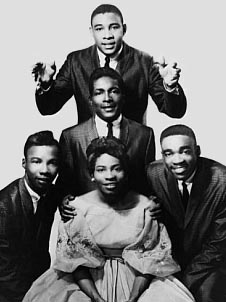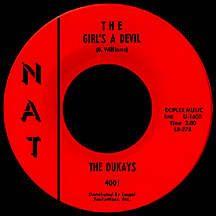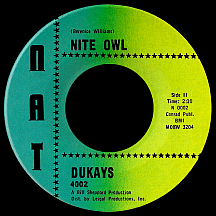THE DUKAYS
The Girl's a Devil
Chicago's Regal Theater, at 47th and South Parkway, had been the premier nightclub for jazz aficionados since 1928; all the top acts performed there including the rhythm and blues singers of the 1950s and beyond. Eugene Dixon lived about a block from the Regal for the first decade of his life, so his desire to be a singer came as no surprise. The Spaniels were his favorite group in the mid-'50s; he patterned his singing style after lead singer Pookie Hudson. In 1955, Eugene started his own outfit, The Gaytones, while attending Englewood High. Around 1957 he hooked up with a local trio led by baritone singer Earl Edwards in addition to tenor James Lowe and bass Ben Broyles; The Dukays became a well-balanced foursome once Dixon was added as lead singer, but any impending brightness in their future was put on hold when he joined the Army. Eugene was stationed in Germany, coincidentally at about the same time as Elvis Presley, but there's no indication the two ever crosed paths (Dixon performed with the Army's Special Services division, while Presley, by then the world's hottest singing star, declined any offers to entertain troops at the insistence of his manager, Colonel Tom Parker).
On returning to civilian life in 1960, he re-upped with the Dukays and suggested an addition to the group in the form of a woman, his cousin Shirley Johnson. The guys were receptive to the idea, since it was uncommon to have a female singer in an otherwise all-male group (The Platters, of course, being the one illustrious exception). She fit in well and lent her soprano voice to the part of first tenor. Songwriter Bernice Williams became aware of the Dukays and in early 1961 she convinced the tiny Nat record label, distibuted by New York-based Lasgal Productions, to record them. At the time, Bernice was handling a local girl group, The Starlets, featuring Earl's sister Maxine Edwards, and they were moving up the charts with a song she'd written, "Better Tell Him No," on Pam, another Lasgal label. Producer Bill Sheppard (affectionately known as "Bunky," he was a steady presence on the '60s soul music scene) produced the Dukays' debut single, "The Girl's a Devil" ('...she tried to make a monkey outta me...but I love her so!'), which gradually developed, hitting the national charts in May and staying there until August, though it never caught on enough to become a major hit.
Six sides were recorded by the Dukays and from the four remaining the label chose "Nite Owl" ('11 o'clock...11:30...curfew time!') for the second single. One of the leftover tracks was a song that had been ad-libbed by the group during a rehearsal; Eugene began playing around with the standard doo wop harmony, "da, da" or "du, du," pronouncing it 'Duke...' (after all, it fit with the group's name) and following with '...Earl,' after Earl Edwards. The song developed from there with input from Bernice. Songwriting credits for "Duke of Earl" went to Williams and Dixon with the addition of Edwards since, accoring to Eugene, it was his name in the title (though Edwards has claimed he actually had more to do with the song's creation than simply lending his name to it).

"Nite Owl" came out in the fall but wasn't as well received by radio as the infectious Devil-Girl record had been. All of a sudden Dixon turned up AWOL; it seems he had cut a deal with Vee-Jay Records to have "Duke of Earl" released as a solo debut, figuring the Nat execs weren't interested (which was correct; they had passed on it). His defection from the group was obvious to all by the time the record appeared with the name Gene Chandler plastered on the label. Earl Edwards, on realizing Eugene had left the group, let it be known he didn't think anything would come of the move and that Dixon, or Chandler, or whatever he wanted to call himself, would be welcomed back to the Dukays once the song failed. But it didn't happen that way; success was almost instantaneous. "Duke of Earl" hit the national charts in January '62 and was the number one record in America just six weeks later. The Dukays had reason to be hopeful as well, if only for a moment or so; "Nite Owl" appeared on the charts a week after "Duke" but ran its course in about a month.
The Dukays knew they were on their own long before "Duke of Earl" had embedded itself in the public's consciousness, a bona fide million-selling smash, and Chandler had begun appearing onstage milking the gimmick sporting a cape, top hat and tails. Through Sheppard, the group obtained their own deal with Vee-Jay. Charles Davis, formerly with Chicago group The Trinidads, took Gene's spot as lead singer; Shirley Johnson left for personal reasons and was replaced by Margaret "Cookie" Stone. In March, six weeks after "Nite Owl" had fallen off the charts, it re-entered on Vee-Jay, then disappeared for good after just one week. "Please Help," a frenzied jungle novelty about a hungry lion, came next, picking up a little play in the Great Lakes area before stalling altogether. Two additional singles fell by the wayside before Vee-Jay sent the group packing.
Davis, Broyles and Stone left in 1963. Original leader Earl Edwards and James Lowe kept the group going, adding two new members, Claude McCrae and Richard Dixon. In 1964 they made a record called "The Jerk" (a different song from The Larks' hit) for Jerry Murray's Jerry-O Records. After one more single for the label, The Dukays threw in the towel. By that time, Gene Chandler was well established as a seriously soulful singing sensation.



